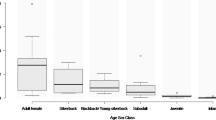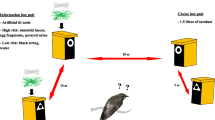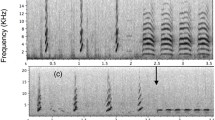Abstract
Animal communities may constitute information networks where individuals gain information on predation risk by eavesdropping on alarm calls of other species. However, communities include species in different trophic levels, and it is not yet known how the trophic level of the receiver influences the informative value of a call. Furthermore, no empirical study has yet tested how increased competition may influence the value of alarm calls for distinct receivers. Here, we identify the importance of alarm calls emitted by a small owl, the little owl (Athene noctua), on the structure of a cavity-nesting bird community including mesopredators and primary prey under variable levels of competition for nest holes. Competitors sharing top predators with the callers and prey of the callers interpreted alarm and non-alarm calls differently. Competitors chose preferentially alarm and non-alarm patches over control patches to breed, while prey selected alarm patches. In contrast, competition for nest sites affected habitat selection of prey species more than that of competitors of the callers. This study provides support for a changing value of alarm calls and competition for nest sites for distinct receivers related to niche overlapping among callers and eavesdroppers, therefore, calling attention to possible cascading effects by the use of information in natural communities.



Similar content being viewed by others
References
Aitken KEH, Martin K (2007) The importance of excavators in hole-nesting communities: availability and use of natural tree holes in old mixed forests of western Canada. J Ornithol 148:S425–S434
Betts MG, Hadley AS, Rodenhouse N, Nocera JJ (2008) Social information trumps vegetation structure in breeding-site selection by a migrant songbird. Proc R Soc B 275:2257–2263
Blumstein DT, Cooley L, Winternitz J et al (2008) Do yellow-bellied marmots respond to predator vocalizations? Behav Ecol Sociobiol 62:457–468
Caro T (2005) Antipredator defenses in birds and mammals, 1st edn. Chicago University Press, Chicago
Couchoux C, Cresswell W (2012) Personality constraints versus flexible antipredation behaviors: how important is boldness in risk management of redshanks (Tringa totanus) foraging in a natural system? Behav Ecol 23:290–301
Cresswell W (2008) Non-lethal effects of predation in birds. Ibis 150:3–17
Cure C, Antunes R, Alves AC et al (2013) Responses of male sperm whales (Physeter macrocephalus) to killer whale sounds: implications for anti-predator strategies. Sci Rep 3:1579
Curio E, Ernst U, Vieth W (1978) Cultural transmission of enemy recognition—one function of mobbing. Science 202:899–901
Dingemanse NJ, Wolf M (2010) Recent models for adaptive personality differences: a review. Phil Trans R Soc London Ser B 365:3947–3958
Doligez B, Danchin E, Clobert J, Gustafsson L (1999) The use of conspecific reproductive success for breeding habitat selection in a non-colonial, hole-nesting species, the collared flycatcher. J Anim Ecol 68:1193–1206
Dukas R (2002) Behavioural and ecological consequences of limited attention. Phil Trans R Soc London Ser B 357:1539–1547
Dukas R, Kamil AC (2000) The costs of limites attention in blue jays. Behav Ecol 11:502–506
Eggers S, Griesser M, Nystrand M et al (2006) Predation risk induces changes in nest-site selection and clutch size in the Siberian jay. P Roy Soc Lond B 273:701–706
Emmering QC, Schmidt KA (2011) Nesting songbirds assess spatial heterogeneity of predatory chipmunks by eavesdropping on their vocalizations. J Anim Ecol 80:1305–1312
Forsman JT, Seppänen JT, Monkkönen M (2002) Positive fitness consequences of interspecific interaction with a potential competitor. P Roy Soc Lond B 269:1619–1623
Forsman JT, Hjernquist MB, Taipale J et al (2008) Competitor density cues for habitat quality facilitating habitat selection and investment decisions. Behav Ecol 19:539–545
Fretwell SD (1972) Populations in a seasonal environment, 1st edn. Princeton University Press, Princeton
Hardouin LA, Tabel P, Bretagnolle V (2006) Neighbour–stranger discrimination in the little owl, Athene noctua. Anim Behav 72:105–112
Hasson O (1991) Pursuit-deterrent signals—communication between prey and predator. Trends Ecol Evol 6:325–329
Laundré JW, Hernández L, Altendorf KB (2001) Wolves, elk, and bison: reestablishing the “landscape of fear” in Yellowstone National Park, USA. Can J Zool 79:1401–1409
Llimosa F, Matheu E, Roché J (1990) Guía sonora de las Aves de España. Alosa, Barcelona, Audiovisual Material
Magrath RD, Bennett TH (2012) A micro-geography of fear: learning to eavesdrop on alarm calls of neighbouring heterospecifics. P Roy Soc Lond B 279:902–909
Magrath RD, Pitcher BJ, Gardner JL (2009) An avian eavesdropping network: alarm signal reliability and heterospecific response. Behav Ecol 20:745–752
Magrath RD, Haff TM, Fallow PM et al (2015) Eavesdropping on heterospecific alarm calls: from mechanisms to consequences. Biol Rev 90:560–586
Marchesi L, Sergio F (2005) Distribution, density, diet and productivity of the Scops Owl Otus scops in the Italian Alps. Ibis 147:176–187
Metcalfe NB, Huntingford FA, Thorpe JE (1987) The influence of predation risk on the feeding motivation and foraging strategy of juvenile Atlantic salmon. Anim Behav 35:901–911
Monkkönen M, Helle P, Soppela K (1990) Numerical and behavioral responses of migrant passerines to experimental manipulation of resident tits (Parus spp.): heterospecific attraction in Northern breeding bird communities. Oecologia 85:218–225
Morosinotto C, Villers A, Thomson RL et al (2017) Competitors and predators alter settlement pattern and reproductive success of an intraguild prey. Ecol Monogr 87:4–20
Newton I (1998) Population limitation in birds, 1st edn. Academic Press, Cambridge
Obuch J, Kristin A (2004) Prey composition of the little owl Athene noctua in an arid zone (Egypt, Syria, Iran). Folia Zool 53:65–79
Parejo D, Avilés JM (2011) Predation risk determines breeding territory choice in a Mediterranean cavity-nesting bird community. Oecologia 165:185–191
Parejo D, Avilés JM (2016) Social information use by competitors: resolving the enigma of species coexistence in animals? Ecosphere 7:1–12
Parejo D, Danchin E, Avilés JM (2005) The heterospecific habitat copying hypothesis: can competitors indicate habitat quality? Behav Ecol 16:96–105
Parejo D, Avilés JM, Rodríguez J (2012) Alarm calls modulate the spatial structure of a breeding owl community. P Roy Soc Lond B Biol 279:2135–2141
Penteriani V, Kuparinen A, Delgado MM et al (2013) Responses of a top and a meso predator and their prey to moon phases. Oecologia 173:753–766
Ridley AR, Wiley EM, Thompson AM (2014) The ecological benefits of interceptive eavesdropping. Funct Ecol 28:197–205
Ritchie EG, Johnson CN (2009) Predator interactions, mesopredator release and biodiversity conservation. Ecol Lett 12:982–998
Sabellis MW, Janssen A, Kant MR (2001) The enemy of my enemy is my ally. Science 291:2104–2105
Schmidt KA (2006) Non-additivity among multiple cues of predation risk: a behaviorally-driven trophic cascade between owls and songbirds. Oikos 113:82–90
Schmidt KA, Belinsky KL (2013) Voices in the dark: predation risk by owls influences dusk singing in a diurnal passerine. Behav Ecol Sociobiol 67:1837–1843
Schmidt KA, Whelan CJ (1999) Nest predation on woodland songbirds: when is nest predation density dependent? Oikos 87:65–74
Schmitz OJ, Hamback PA, Beckerman AP (2000) Trophic cascades in terrestrial systems: a review of the effects of carnivore removals on plants. Am Nat 155:141–153
Seppänen JT, Forsman JT, Monkkönen M et al (2007) Social information use is a process across time, space, and ecology, reaching heterospecifics. Ecology 88:1622–1633
Seyfarth R, Cheney D (1990) The assessment by vervet monkeys of their own and another species alarm calls. Anim Behav 40:754–764
Suhonen J (1993) Predation risk influences the use of foraging sites by tits. Ecology 74:1197–1203
Szymkowiak J, Kuczyński L (2015) Predation-related costs and benefits of conspecific attraction in songbirds—an agent-based approach. PLoS ONE 10:e0119132
Szymkowiak J, Thomson RL, Kuczynski L (2016) Wood warblers copy settlement decisions of poor quality conspecifics: support for the tradeoff between the benefit of social information use and competition avoidance. Oikos 125:1561–1569
Templeton CN, Greene E (2007) Nuthatches eavesdrop on variations in heterospecific chickadee mobbing alarm calls. Proc Nat Acad Sci USA 104:5479–5482
Tome R, Catry P, Bloise C et al (2008) Breeding density and success, and diet composition of Little Owls Athene noctua in steppe-like habitats in Portugal. Ornis Fennica 85:22–32
Vitousek MN, Adelman JS, Gregory NC et al (2007) Heterospecific alarm call recognition in a non-vocal reptile. Biol Lett 3:632–634
Weary DM, Kramer DL (1995) Response of eastern chipmunks to conspecific alarm calls. Anim Behav 49:81–93
Zanette LY, White AF, Allen MC et al (2011) Perceived predation risk reduces the number of offspring songbirds produce per year. Science 334:1398–1401
Acknowledgements
We are grateful to Jukka Forsman and Mikko Mokkönen for constructive and helpful comments on an earlier version of the manuscript. This study was funded by the Spanish Ministries of Education and Science/FEDER and of Economy and Competitiveness, respectively, through the projects CGL2011-27561/BOS, CGL2014-56769-P and by the Government of Extremadura through the contract TA13002 to DP.
Author information
Authors and Affiliations
Contributions
DP and JMA designed the study. DP, JMA and MEG collected field data. DP carried out the statistical analyses and wrote a first version of the manuscript that was discussed, revised and approved for all the authors. MEG makes the drawings of Fig. 1.
Corresponding author
Additional information
Communicated by Markku Orell.
Electronic supplementary material
Below is the link to the electronic supplementary material.
Rights and permissions
About this article
Cite this article
Parejo, D., Avilés, J.M. & Expósito-Granados, M. Receivers matter: the meaning of alarm calls and competition for nest sites in a bird community. Oecologia 187, 707–717 (2018). https://doi.org/10.1007/s00442-018-4139-x
Received:
Accepted:
Published:
Issue Date:
DOI: https://doi.org/10.1007/s00442-018-4139-x




